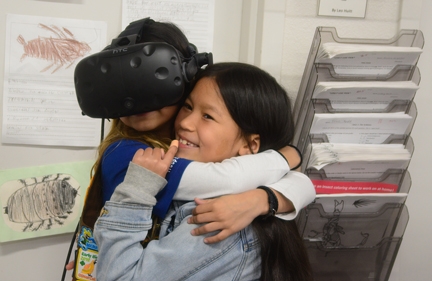
Be sure to head over to Briggs Hall on Saturday, April 13 during the 105th annual UC Davis Picnic Day to see or participate in medical entomologist/geneticist Geoffrey Attardo's virtual reality (VR) demonstration. It's free and family friendly.
Attardo describes VR as a "computer-generated simulation used to simulate real or imagined environments. It immerses the user by stimulating visual, auditory and touch-based senses."
In other words, VR is an interactive, three-dimensional, computer-generated experience. You'll enter the fascinating, breathtaking world of insects and arthropods on a scale you've never before imagined. Tiny critters that are easy to overlook can't be overlooked in the VR world.
Attardo, an assistant professor in the Department of Entomology and Nematology, drew crowds all day long at last year's "Virtual Reality Bugs" at UC Davis Picnic Day, and no doubt he'll do so again. Briggs Hall activities begin at 9 a.m. and conclude around 4:30.
Attardo presented a seminar titled "Using Virtual Reality to Engage and Instruct: a A Novel Tool for Outreach and Extension," at the 2018 Entomological Society of America (ESA) meeting in Vancouver, B.C.
"Recent developments in computer and display technologies are providing novel ways to interact with information," he told the ESA attendees. "One of these innovations is the development of Virtual Reality (VR) hardware. Innovations in hardware and software have made this technology broadly accessible with options ranging from cell phone based VR kits made of cardboard to dedicated headsets driven by computers using powerful graphical hardware. VR based educational experiences provide opportunities to present content in a form where they are experienced in 3 dimensions and are interactive."
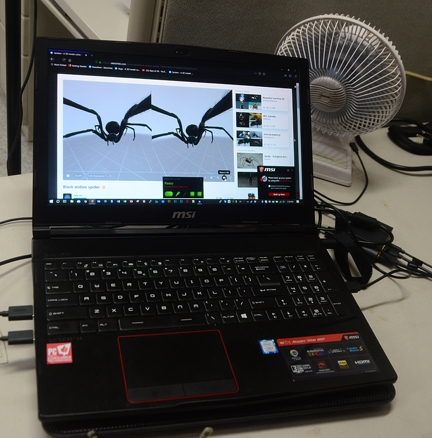
Attardo says that "VR has great potential as a new way to present entomological content including aspects of morphology, physiology, behavior and other aspects of insect biology. This demonstration allows users of all ages to view static and animated 3D models of insects and arthropods in virtual reality."
The system he uses? A HTC Vive driven by a VR ready laptop. You can see his three-dimensional insect models on Sketchfab.com, using the Firefox web browser. In addition, you can view the models in two dimensions on any computer with most web browsers.
In his presentation to ESA, Attardo commented: "This isn't your parents' virtual reality! Early computers and monitors could not produce the frame rate/resolution required. Early attempts at VR were heavy, awkward and motion-sickness inducing. Increased processing power, smaller computers and high resolution screens have solved these issues."
How does VR work? For software, you need a graphical engine to build a world, content for inclusion in the world, and interactivity, with the world responding to the user via artificial intelligence. You need headsets, your windows into the virtual world. Controls assist the user in interacting with the world.
Attardo says that VR can be used for surgical training, data visualization, engineering, and "making big things small and small things big." It can also be used for physical and psychological therapy, such as evaluation of cognitive function in Alzheimer's patients, anxiety reduction in dementia patients, reduction in pre-surgery anxiety,post-traumatic stress disorder (PTSD) therapy, and reduction in pain associated with dental procedures.
How can VR be used in education? At the ESA meeting, the UC Davis faculty member listed these six educational benefits:
- Reduces or eliminates distractions
- Experienced-based learning
- VR-based experiences facilitate better recall due to spatial associations
- Content is interactive and explorable at the student's pace
- Visual classrooms allow long-distance learning
- Engaging
He attributed "better recall to spatial associations" to a research paper, Virtual Memory Palaces: Immersion Aids Recall, by E. Krokos, et al., published in 2018 in Virtual Reality.
Yes, there are some negatives along with the positives. The system can be expensive, you can encounter potential technical issues, it's limited to available content, and you'll need multiple sets of hardware. Plus, content development software has a steep learning curve, he said.
Attardo joined the UC Davis Department of Entomology and Nematology in 2017 from Yale University School of Public Health, New Haven, Conn., where he served as a research scientist. A native of Poughkeepsie, N.Y., he received a bachelor's degree in entomology from the University of Massachusetts, Amherst, in 1994 and his doctorate in genetics from Michigan State University, East Lansing, in 2004.
At UC Davis, his lab focuses on aspects of the physiology of tsetse fly reproduction.
“As a scientist, I have taken my fascination with the magnifying things to the extreme in that my work tends to focus on the molecular biology underlying the physiology of insect adaptations," he told us in a 2017 interview. "The molecular adaptations are just as amazing as the morphological ones. However, they are even harder to visualize and explain to lay people. I enjoy illustration and artwork as well, so when it is not possible to take a picture of something I am working on, I try to create a visual representation of it.”
“I also really enjoy digital illustration and have recently gotten into 3D modeling. My first model is a tsetse fly for which I was able to use my macro photos to texture." See https://sketchfab.com/models/263750e5a9c54c56a77d63ac06f2f317
Attardo demonstrated his system at a recent Bohart Museum of Entomology open house, where participants of all ages engaged with three-dimensional gigantic spiders. Several members of a Brownie Girl Scout Troop from Vacaville giggled and held on to each other. Lynn Kimsey, director of the Bohart Museum, looked at the spiders, looked at them and said "I just want to collect them!"
Attached Images:
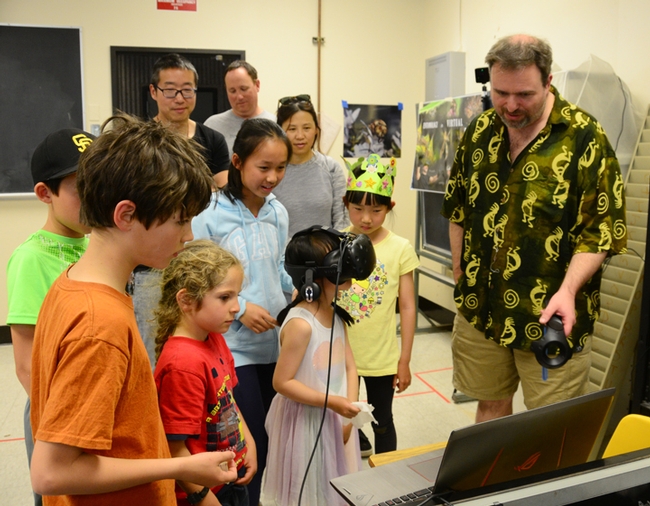
Medical entomologist Geoffrey Attardo and his "Virtual Reality Bugs" demonstration drew participants all day long at the 2018 UC Davis Picnic Day. He'll do so again this Saturday. (Photo by Kathy Keatley Garvey)
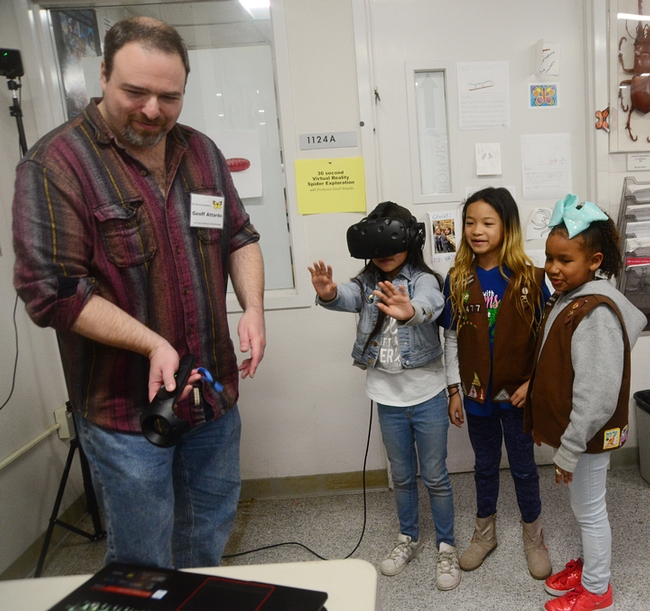
At a recent Bohart Museum of Entomology open house on spiders, medical entomologist Geoffrey Attardo demonstrated his virtual reality system. The girls, members of Brownie Girl Scout Troop 30477, Vacaville, are (from left) Jayda Navarrette, 8; Keira Yu, 8, and Kendl Macklin, 7. (Photo by Kathy Keatley Garvey)
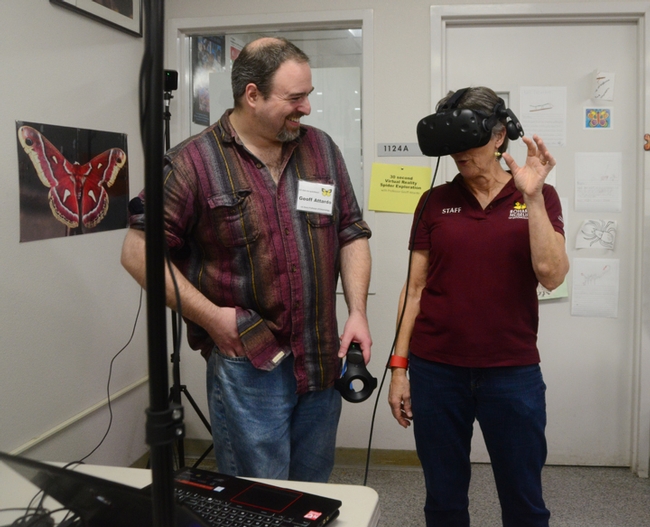
Lynn Kimsey, director of the Bohart Museum of Entomology, experiences Virtual Reality with spiders. "I just want to collect them," she said. With her is medical entomologist Geoffrey Attardo. (Photo by Kathy Keatley Garvey)